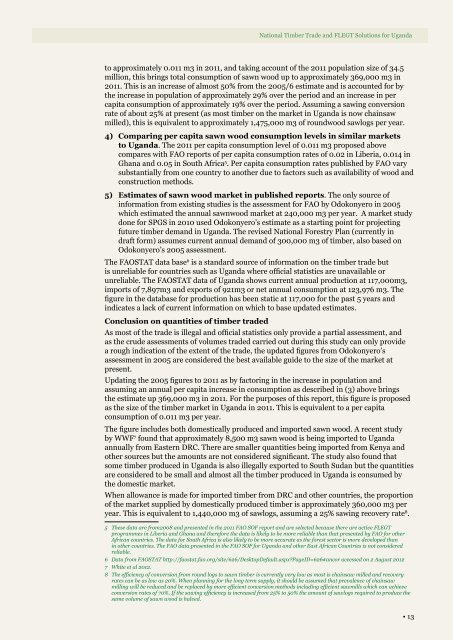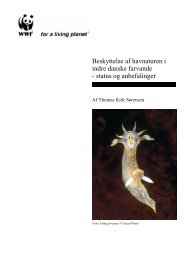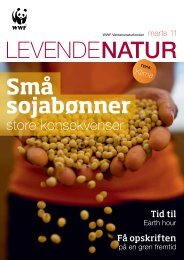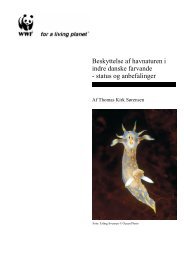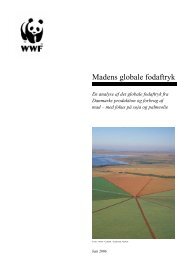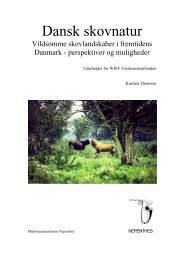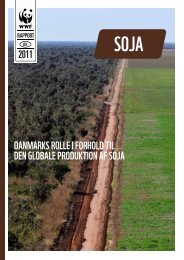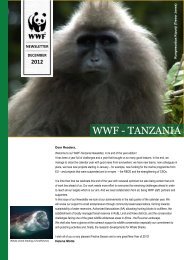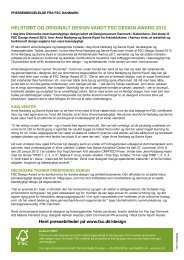NatioNal timber trade aNd FleGt SolutioNS For uGaNda - WWF
NatioNal timber trade aNd FleGt SolutioNS For uGaNda - WWF
NatioNal timber trade aNd FleGt SolutioNS For uGaNda - WWF
Create successful ePaper yourself
Turn your PDF publications into a flip-book with our unique Google optimized e-Paper software.
National Timber Trade and FLEGT Solutions for Uganda<br />
to approximately 0.011 m3 in 2011, and taking account of the 2011 population size of 34.5<br />
million, this brings total consumption of sawn wood up to approximately 369,000 m3 in<br />
2011. This is an increase of almost 50% from the 2005/6 estimate and is accounted for by<br />
the increase in population of approximately 29% over the period and an increase in per<br />
capita consumption of approximately 19% over the period. Assuming a sawing conversion<br />
rate of about 25% at present (as most <strong>timber</strong> on the market in Uganda is now chainsaw<br />
milled), this is equivalent to approximately 1,475,000 m3 of roundwood sawlogs per year.<br />
4) Comparing per capita sawn wood consumption levels in similar markets<br />
to Uganda. The 2011 per capita consumption level of 0.011 m3 proposed above<br />
compares with FAO reports of per capita consumption rates of 0.02 in Liberia, 0.014 in<br />
Ghana and 0.05 in South Africa5 . Per capita consumption rates published by FAO vary<br />
substantially from one country to another due to factors such as availability of wood and<br />
construction methods.<br />
5) Estimates of sawn wood market in published reports. The only source of<br />
information from existing studies is the assessment for FAO by Odokonyero in 2005<br />
which estimated the annual sawnwood market at 240,000 m3 per year. A market study<br />
done for SPGS in 2010 used Odokonyero’s estimate as a starting point for projecting<br />
future <strong>timber</strong> demand in Uganda. The revised National <strong>For</strong>estry Plan (currently in<br />
draft form) assumes current annual demand of 300,000 m3 of <strong>timber</strong>, also based on<br />
Odokonyero’s 2005 assessment.<br />
The FAOSTAT data base6 is a standard source of information on the <strong>timber</strong> <strong>trade</strong> but<br />
is unreliable for countries such as Uganda where official statistics are unavailable or<br />
unreliable. The FAOSTAT data of Uganda shows current annual production at 117,000m3,<br />
imports of 7,897m3 and exports of 921m3 or net annual consumption at 123,976 m3. The<br />
figure in the database for production has been static at 117,000 for the past 5 years and<br />
indicates a lack of current information on which to base updated estimates.<br />
Conclusion on quantities of <strong>timber</strong> <strong>trade</strong>d<br />
As most of the <strong>trade</strong> is illegal and official statistics only provide a partial assessment, and<br />
as the crude assessments of volumes <strong>trade</strong>d carried out during this study can only provide<br />
a rough indication of the extent of the <strong>trade</strong>, the updated figures from Odokonyero’s<br />
assessment in 2005 are considered the best available guide to the size of the market at<br />
present.<br />
Updating the 2005 figures to 2011 as by factoring in the increase in population and<br />
assuming an annual per capita increase in consumption as described in (3) above brings<br />
the estimate up 369,000 m3 in 2011. <strong>For</strong> the purposes of this report, this figure is proposed<br />
as the size of the <strong>timber</strong> market in Uganda in 2011. This is equivalent to a per capita<br />
consumption of 0.011 m3 per year.<br />
The figure includes both domestically produced and imported sawn wood. A recent study<br />
by <strong>WWF</strong>7 found that approximately 8,500 m3 sawn wood is being imported to Uganda<br />
annually from Eastern DRC. There are smaller quantities being imported from Kenya and<br />
other sources but the amounts are not considered significant. The study also found that<br />
some <strong>timber</strong> produced in Uganda is also illegally exported to South Sudan but the quantities<br />
are considered to be small and almost all the <strong>timber</strong> produced in Uganda is consumed by<br />
the domestic market.<br />
When allowance is made for imported <strong>timber</strong> from DRC and other countries, the proportion<br />
of the market supplied by domestically produced <strong>timber</strong> is approximately 360,000 m3 per<br />
year. This is equivalent to 1,440,000 m3 of sawlogs, assuming a 25% sawing recovery rate8 .<br />
5 These data are from2008 and presented in the 2011 FAO SOF report and are selected because there are active FLEGT<br />
programmes in Liberia and Ghana and therefore the data is likely to be more reliable than that presented by FAO for other<br />
African countries. The data for South Africa is also likely to be more accurate as the forest sector is more developed than<br />
in other countries. The FAO data presented in the FAO SOF for Uganda and other East African Countries is not considered<br />
reliable.<br />
6 Data from FAOSTAT http://faostat.fao.org/site/626/DesktopDefault.aspx?PageID=626#ancor accessed on 2 August 2012<br />
7 White et al 2012.<br />
8 The efficiency of conversion from round logs to sawn <strong>timber</strong> is currently very low as most is chainsaw milled and recovery<br />
rates can be as low as 20%. When planning for the long term supply, it should be assumed that prevalence of chainsaw<br />
milling will be reduced and be replaced by more efficient conversion methods including efficient sawmills which can achieve<br />
conversion rates of 70%. If the sawing efficiency is increased from 25% to 50% the amount of sawlogs required to produce the<br />
same volume of sawn wood is halved.<br />
• 13


